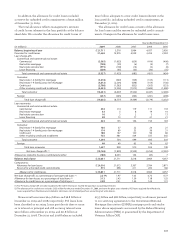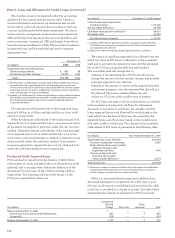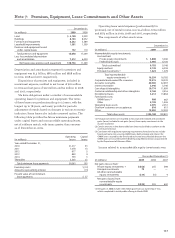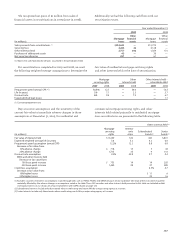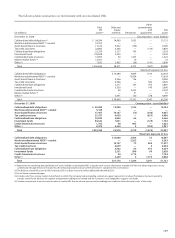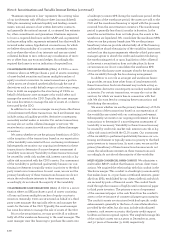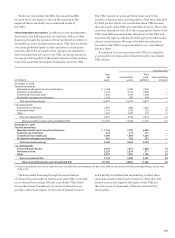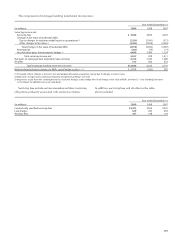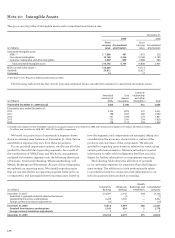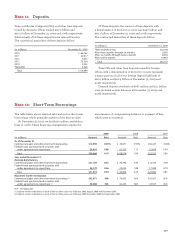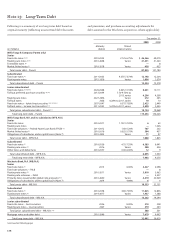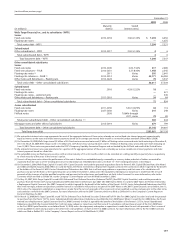Wells Fargo 2009 Annual Report Download - page 132
Download and view the complete annual report
Please find page 132 of the 2009 Wells Fargo annual report below. You can navigate through the pages in the report by either clicking on the pages listed below, or by using the keyword search tool below to find specific information within the annual report.
“Maximum exposure to loss” represents the carrying value
of our involvement with off-balance sheet (unconsolidated)
VIEs plus remaining undrawn liquidity and lending commit-
ments, notional amount of net written derivative contracts,
and generally the notional amount of, or stressed loss estimate
for, other commitments and guarantees. Maximum exposure
to loss is a required disclosure under GAAP and, as presented
in the preceding table, represents estimated loss that would be
incurred under severe, hypothetical circumstances, for which
we believe the possibility of occurrence is extremely remote,
such as where the value of our interests and any associated
collateral declines to zero, without any consideration of recov-
ery or offset from any economic hedges. Accordingly, this
required disclosure is not an indication of expected loss.
COLLATERALIZED DEBT OBLIGATIONS (CDOS)A CDO is a secu -
ritization where an SPE purchases a pool of assets consisting
of asset-backed securities and issues multiple tranches of
equity or notes to investors. In some transactions a portion
of the assets are obtained synthetically through the use of
derivatives such as credit default swaps or total return swaps.
Prior to 2008, we engaged in the structuring of CDOs on
behalf of third party asset managers who would select and
manage the assets for the CDO. Typically, the asset manager
has some discretion to manage the sale of assets of, or deriva-
tives used by the CDO.
In addition to our role as arranger we may have other forms
of involvement with these transactions. Such involvement may
include acting as liquidity provider, derivative counterparty,
secondary market maker or investor. For certain transactions,
we may also act as the collateral manager or servicer. We
receive fees in connection with our role as collateral manager
or servicer.
We assess whether we are the primary beneficiary of CDOs
at the inception of the transactions based on our expectation
of the variability associated with our continuing involvement.
Subsequently, we monitor our ongoing involvement in these
transactions to determine if a more frequent assessment of
variability is necessary. Variability in these transactions may
be created by credit risk, market risk, interest rate risk or liq-
uidity risk associated with the CDO’s assets. Our assessment
of the variability is performed qualitatively because our con-
tinuing involvement is typically senior in priority to the third
party investors in transactions. In most cases, we are not the
primary beneficiary of these transactions because we do not
retain the subordinate interests in these transactions and,
accordingly, do not absorb the majority of the variability.
COLLATERALIZED LOAN OBLIGATIONS (CLOS)A CLO is a securi-
tization where an SPE purchases a pool of assets consisting
of loans and issues multiple tranches of equity or notes to
investors. Generally, CLOs are structured on behalf of a third
party asset manager that typically selects and manages the
assets for the term of the CLO. Typically, the asset manager
has some discretion to manage the sale of assets of the CLO.
Prior to the securitization, we may provide all or substan-
tially all of the warehouse financing to the asset manager. The
asset manager uses this financing to purchase the assets into
a bankruptcy remote SPE during the warehouse period. At the
completion of the warehouse period, the assets are sold to the
CLO and the warehouse financing is repaid with the proceeds
received from the securitization’s investors. The warehousing
period is generally less than 12 months in duration. In the
event the securitization does not take place, the assets in the
warehouse are liquidated. We consolidate the warehouse SPEs
when we are the primary beneficiary. We are the primary
beneficiary when we provide substantially all of the financing
and therefore absorb the majority of the variability. Sometimes
we have loss sharing arrangements whereby a third party asset
manager agrees to absorb the credit and market risk during
the warehousing period or upon liquidation of the collateral
in the event a securitization does not take place. In those
circumstances we do not consolidate the warehouse SPE
because the third party asset manager absorbs the majority
of the variability through the loss sharing arrangement.
In addition to our role as arranger and warehouse financ-
ing provider, we may have other forms of involvement with
these transactions. Such involvement may include acting as
underwriter, derivative counterparty, secondary market maker
or investor. For certain transactions, we may also act as the
servicer, for which we receive fees in connection with that
role. We also earn fees for arranging these transactions and
distributing the securities.
We assess whether we are the primary beneficiary of CLOs
at inception of the transactions based on our expectation of
the variability associated with our continuing involvement.
Subsequently, we monitor our ongoing involvement in these
transactions to determine if a more frequent assessment of
variability is necessary. Variability in these transactions may
be created by credit risk, market risk, interest rate risk or liq-
uidity risk associated with the CLO’s assets. Our assessment
of the variability is performed qualitatively because our con-
tinuing involvement is typically senior in priority to the third
party investors in transactions. In most cases, we are not the
primary beneficiary of these transactions because we do not
retain the subordinate interests in these transactions and,
accordingly, do not absorb the majority of the variability.
MULTI-SELLER COMMERCIAL PAPER CONDUIT We administer a
multi-seller ABCP conduit that finances certain client trans-
actions. We acquired the relationship with this conduit in the
Wachovia merger. This conduit is a bankruptcy remote entity
that makes loans to, or purchases certificated interests, gener-
ally from SPEs, established by our clients (sellers) and which
are secured by pools of financial assets. The conduit funds
itself through the issuance of highly rated commercial paper
to third party investors. The primary source of repayment
of the commercial paper is the cash flows from the conduit’s
assets or the re-issuance of commercial paper upon maturity.
The conduit’s assets are structured with deal-specific credit
enhancements generally in the form of overcollateralization
provided by the seller, but also may include subordinated
interests, cash reserve accounts, third party credit support
facilities and excess spread capture. The weighted-average life
of the conduit’s assets was 2.5 years at December 31, 2009,
and 3.0 years at December 31, 2008, respectively.
Note 8: Securitizations and Variable Interest Entities (continued)



